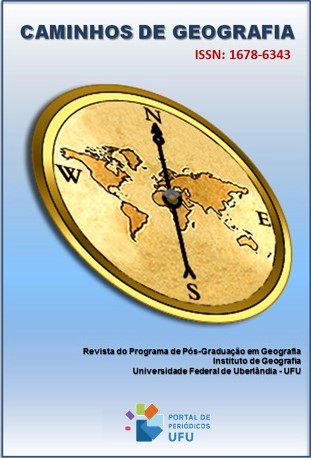POTENCIAL EROSIVO DA BACIA HIDROGRÁFICA DO RIO JABOATÃO - PE
DOI:
https://doi.org/10.14393/RCG249162489Palabras clave:
Álgebra de mapas, Geoprocessamento, Problemas ambientais, SoloResumen
O processo erosivo é um dos mais danosos causadores de degradação ambiental. Um diagnóstico do potencial erosivo de uma região pode auxiliar no entendimento dos mecanismos que atuam nas áreas naturais e antropizadas, tornando possível a orientação das atividades a serem desenvolvidas. Desse modo, o objetivo do presente estudo foi analisar os riscos decorrentes da suscetibilidade natural à erosão da bacia hidrográfica do rio Jaboatão-PE. Para isso, utilizou-se a metodologia de mapeamento e análise da suscetibilidade natural à perda de solo que se baseia nos conceitos de estabilidade e instabilidade ambiental. Realizou-se uma avaliação do balanço existente entre os processos de morfogênese/pedogênese por meio dos atributos da paisagem: pedologia, geologia, declividade, cobertura vegetal e intensidade pluviométrica, com a utilização de ferramentas de geoprocessamento. Por fim, realizaram-se trabalhos de campo para análise dos riscos decorrentes dos processos erosivos presentes na bacia. Foi possível verificar que em 70% da área predomina a classe de erosão medianamente estável/suscetível, e a bacia apresenta uma quantidade significativa de locais com construções em áreas propícias a movimentos gravitacionais de massa, com alto grau natural de suscetibilidade, demonstrando, assim, a necessidade de medidas conservacionistas para a diminuição dos riscos.
Descargas
Descargas
Publicado
Número
Sección
Licencia
Derechos de autor 2023 Izabelly Victoria Alves de Oliveira, Deivid Damião Roque de Souza, Manuella Vieira Barbosa Neto, Marcelo Ricardo Bezerra de Miranda

Esta obra está bajo una licencia internacional Creative Commons Atribución-NoComercial-SinDerivadas 4.0.
Los autores que publican en esta Revista aceptan los siguientes términos: a) Autores conserva los derechos de autor y otorga a la revista el derecho de primera publicación, con el trabajo bajo licencia Creative Commons Attribution-NonCommercial NoDerivs 4.0 International. b) Se permite y anima a los autores a publicar y distribuya su trabajo en línea (por ejemplo, en repositorios institucionales o en su sitio web personal), ya que esto puede generar cambios productivos, así como incrementar el impacto y cita de trabajo publicado. c) Por el hecho de aparecer en este diario de acceso público, los artículos son de libre uso, con sus propias atribuciones, en aplicaciones educativos y no comerciales.











